
- •CONTENTS
- •PREFACE
- •Pencils
- •Papers
- •Accessories
- •Holding the Pencil
- •Pressure
- •Movement of the Hand
- •Lines and Strokes
- •Introduction
- •Observation and Recording
- •Landscape Sketching
- •Trees
- •Trees in the Foreground
- •Trees in the Background
- •Landforms
- •Water
- •Architecture
- •Sketching the Cityscape
- •SKETCHING FROM MEMORY
- •EXAMPLES
- •INDEX
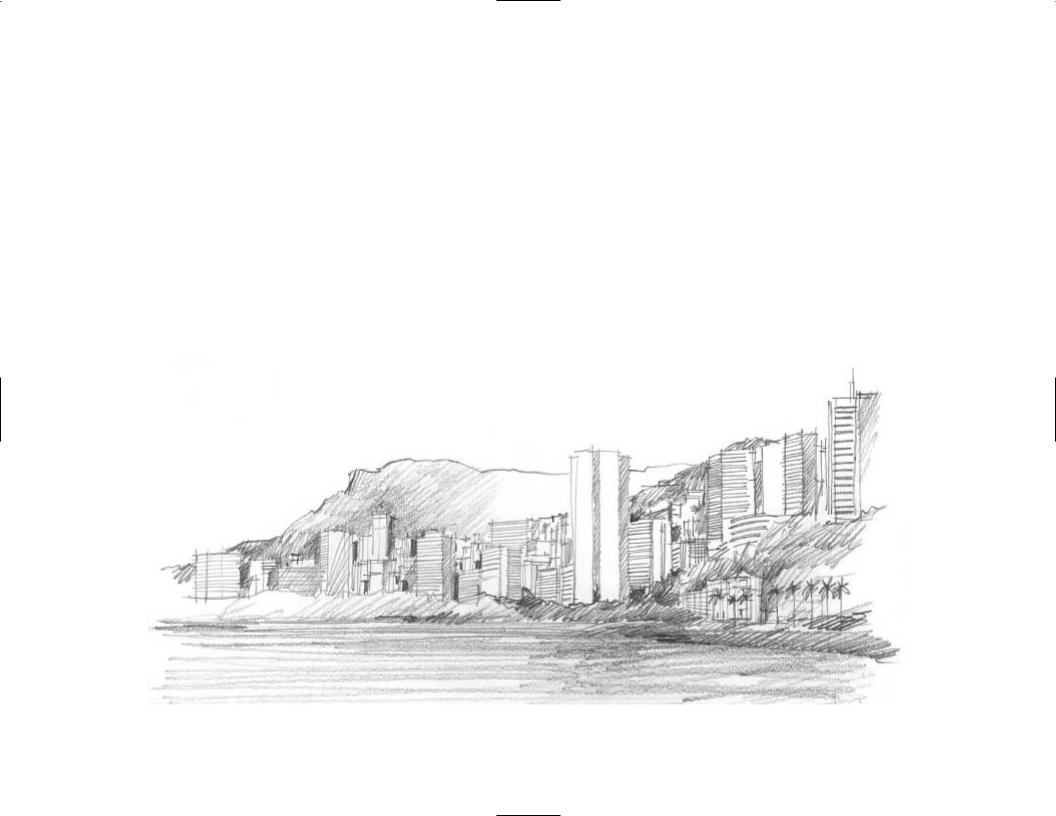
Sketching the Cityscape
City and town are filled with visual excitements and are some of the best subjects to sketch on location. Cityscape tends to be dominated by buildings, but it is the spaces between buildings that become the most attractive thing of all. In addition to the different styles of architecture, street furnishings such as streetlights, signs, awnings, storefronts, and display windows all contribute to enhancing the colorful street life. This sort of multidimensional space is ideal, as it has all the proper ingredients to make a good sketch. They include: a controlled space with strong vertical and horizontal reference planes; interesting architecture; great potential to manipulate light and tonal values; and most important of all, a scale which allows the viewer to walk right into the space through the sketch. The emotional affinity possible in this kind of sketch is far more seductive than a wide-open landscape.
Monte Carlo, Monaco; #2 pencil
67

Alley in Annecy, France
68
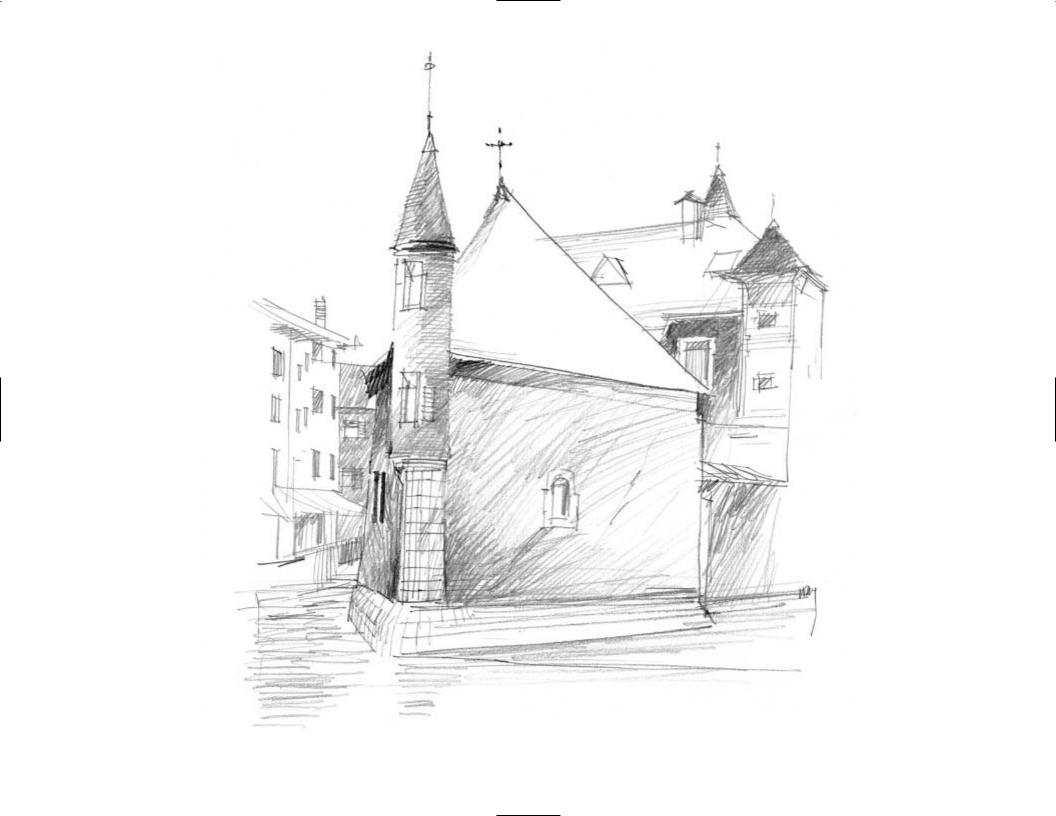
Annecy, France
69
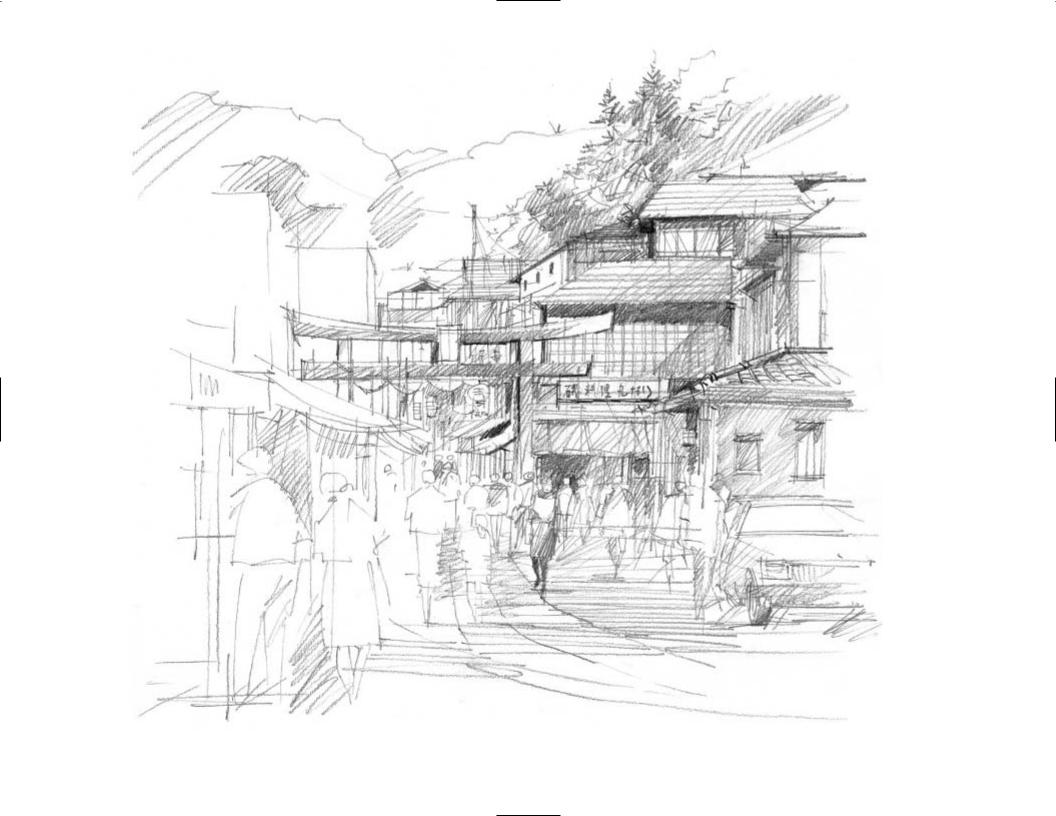
Kamakura, Japan; 2B pencil
70

COMPOSITION 5
Nagoya Castle, Japan; 314 pencil
I mentioned the act of observation in the previous chapter as the most important part in sketching. Here I would like to reemphasize it. A good sketch begins with careful observation and
creative seeing. Creative seeing has to do with learning how to isolate things. Earnest Watson said in his book The Art of Pencil Sketching that “in pencil drawing, one always avoids any leaning
toward photographic simulation.” How true that is. Sketching is about capturing the essence of the real thing. A sketch represents a new language, very much like a shorthand that records the real thing with abbreviated symbols of lines and textures. Creative seeing is about finding the prominent feature, showcasing it, and discarding the rest. It is about capturing the skeletal structure and the spirit that transcends it. Surely, the real thing can be a disorganized mess, but a good sketch knows what to discard.
Composition is part of the entire creative seeing process. It involves visual selection, visual ranking, and visual focus. Perhaps we know what to discard, but what do we do with the items that we keep? How do we rank them in the order that we want to emphasize them in a sketch? For example, should the focus be on the doorway or the windows? How do we isolate the point of interest and use contrast to highlight the importance? How do we balance tone and value, and how do we frame the sketch in order to visually lead the viewers into the picture? By addressing these questions successfully, a good composition has the rare ability to unite the artist and viewer both visually and emotionally.
71
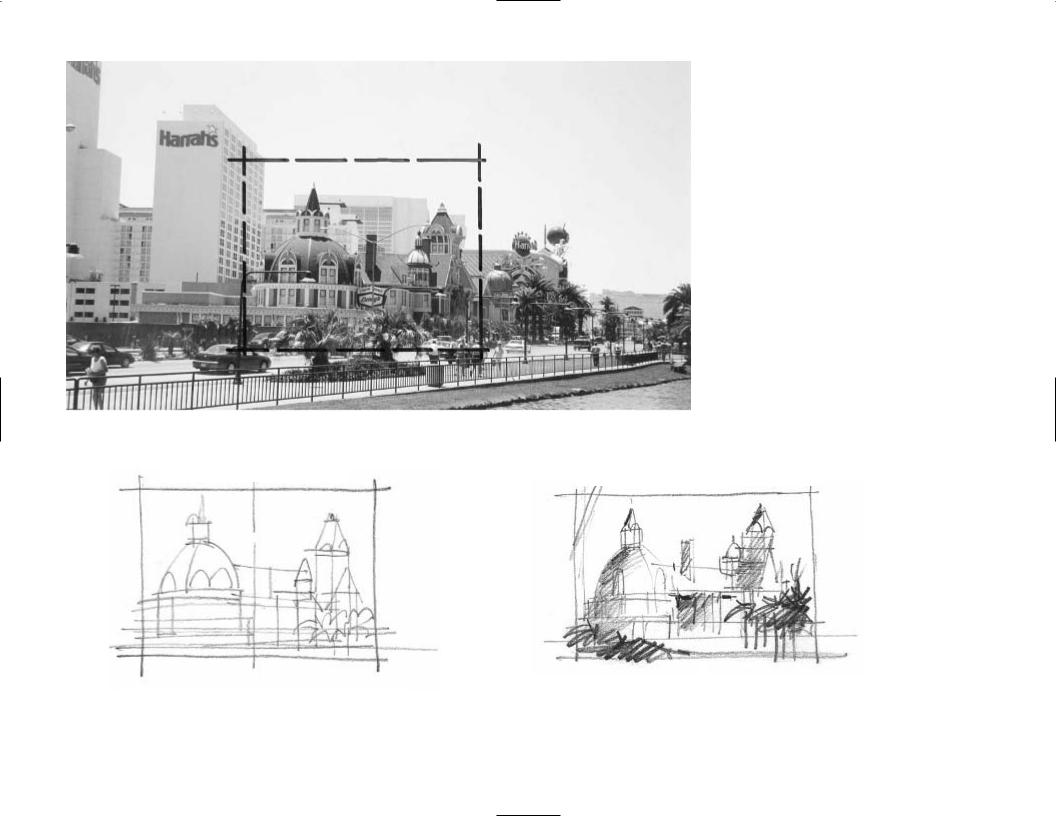
THUMBNAIL STUDY A
Isolate image area; sketch a quick massing diagram to check scale and proportion.
SKETCHING: ISOLATION AND
ABSTRACTION
EXAMPLE 1: TYPICAL LAS VEGAS
STRIP SCENE
Knowing that there is too much to sketch, one must first isolate the object of interest by putting a frame around it.
THUMBNAIL STUDY B
A quick tonal study to explore light and shade; explore ways of framing the picture area.
72
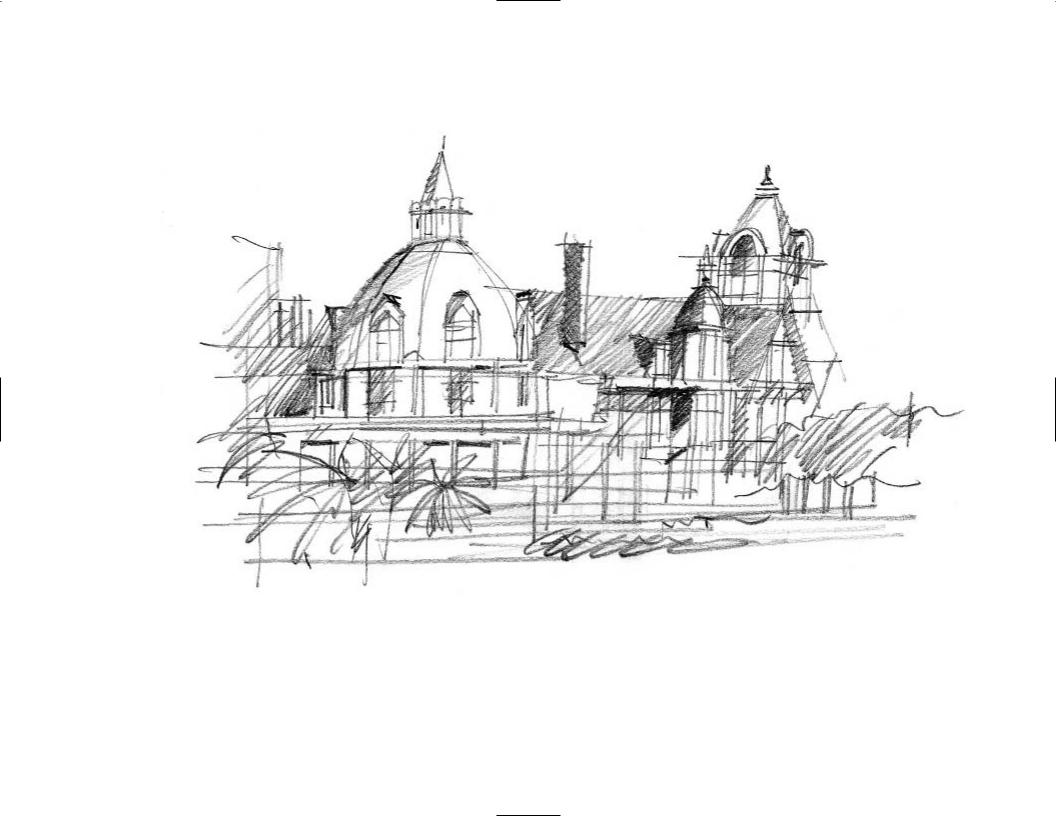
FINISHED SKETCH (full-size with ebony pencil)
Shade the roof and use contrast to separate it from the domes and tower.
Ignore cars and other foreground material; move palms over to the left to use as foreground framing device.
Highlight overhangs and eaves with darker tones to exaggerate the 3-dimensional quality of the architecture.
73

THUMBNAIL
•
•
•
•
SKETCHING: ISOLATION AND
ABSTRACTION
EXAMPLE 2: PLAZA, TOKYO
FORUM
The intent is to sketch the space between buildings; the frame in this case must therefore include the two rows of trees (which creates a large picture frame).
establish a simple massing study
identify all reference planes
a row of trees is a typical vertical reference plane
the ground plane is a typical horizontal reference plane
74

FINISHED SKETCH (full-size with 314 pencil)
•
•
•
avoid overdoing it
take out details, simplify the forms
use simple lines and shading
Shading of ground plane clarifies the tree forms.
Darker contrast at center of vision — this is where you want your eyes to focus.
75
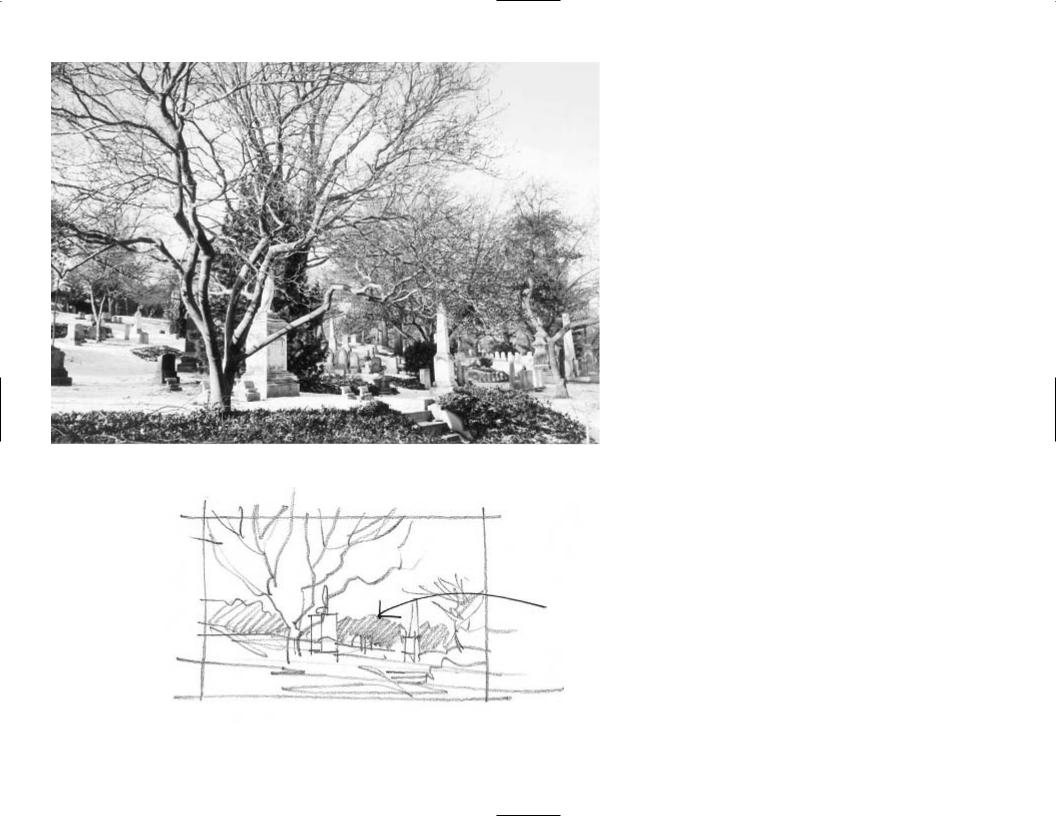
SKETCHING: ISOLATION AND ABSTRACTION
EXAMPLE 3: MOUNT AUBURN CEMETERY
The intent is to sketch the tree in the foreground plus a few tombstones and the monument. The key is to ignore most of the background: you must learn how to visually lift your objects of interest up from the messy background.
THUMBNAIL
Consolidate all backgrounds into a simple shaded plane.
76
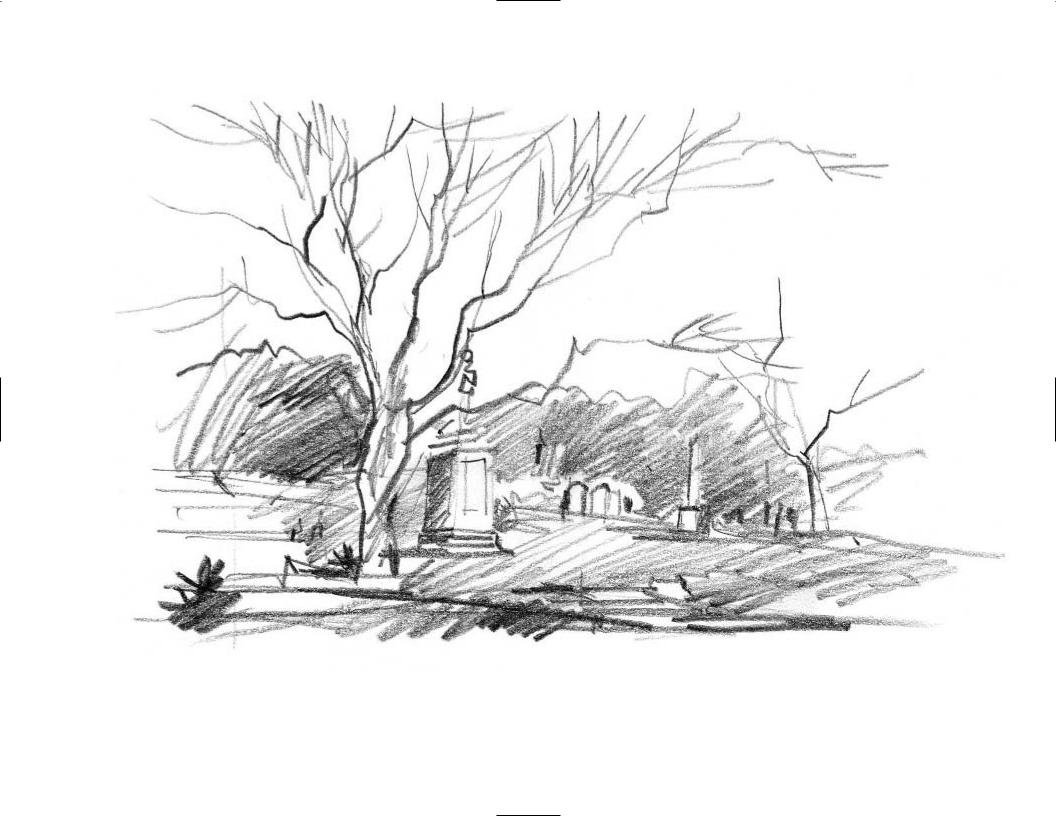
FINISHED SKETCH (full-size with rectangular sketching pencil)
Notice the broad strokes created by the rectangular chisel-pointed lead; it can cover an area quicker than using a sharp, hard pencil. The chisel point is an excellent choice for sketching trees — especially the branches and twigs.
77
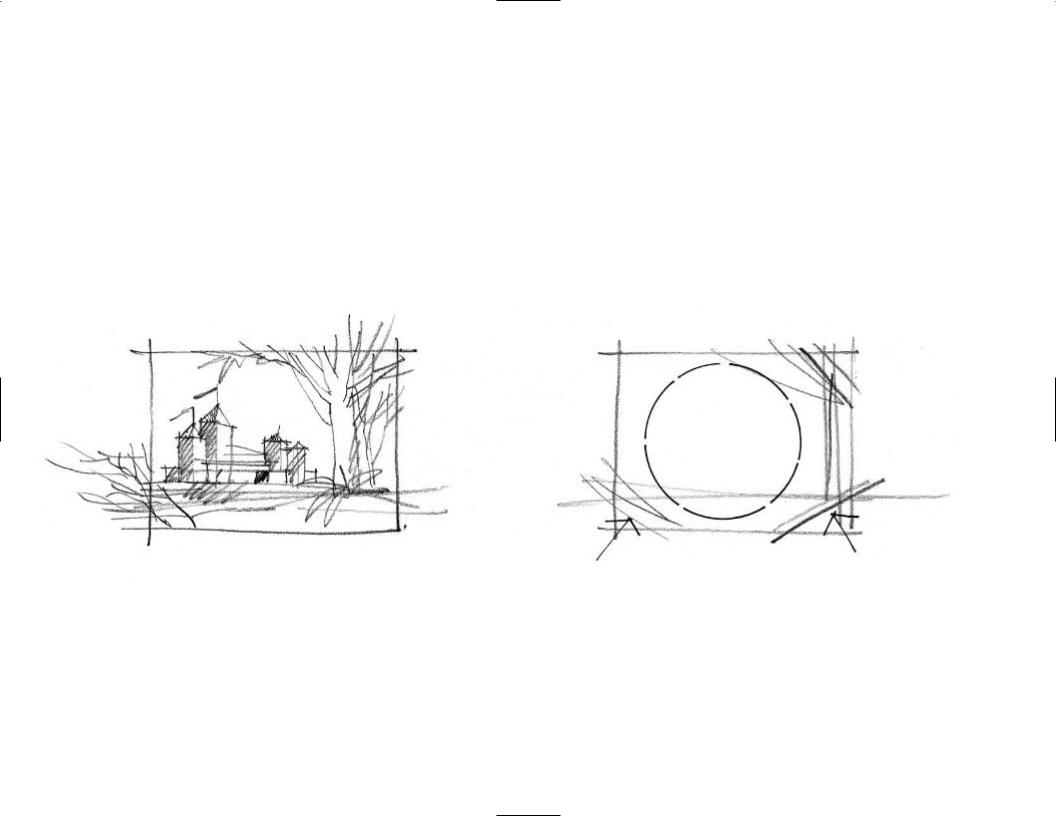
KEY ELEMENTS OF COMPOSITION
1. FRAMING
•using foreground devices to frame the image area
•using foreground devices to direct the attention toward the “theme,” which is placed near the center of the page
THEME
A typical sketch
Framing device |
Framing device |
78
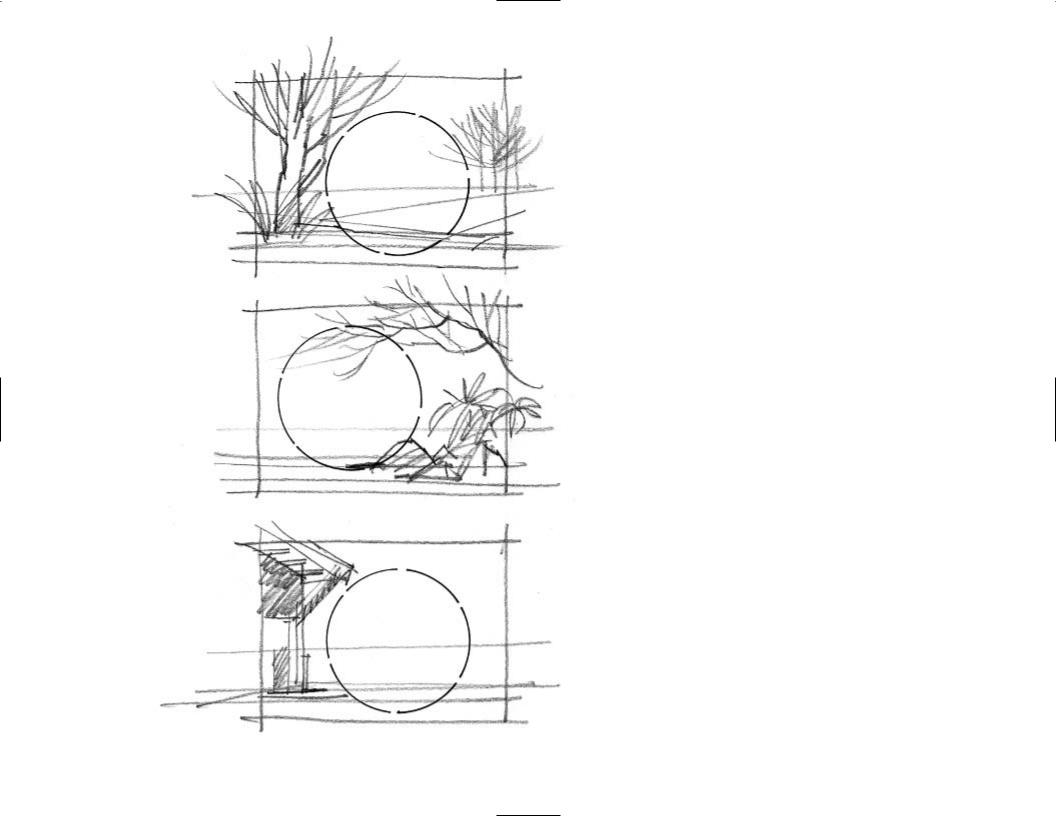
Foreground tree, tree trunk
Foreground foliage, hanging branch, and rocks
Corner of a foreground building
79
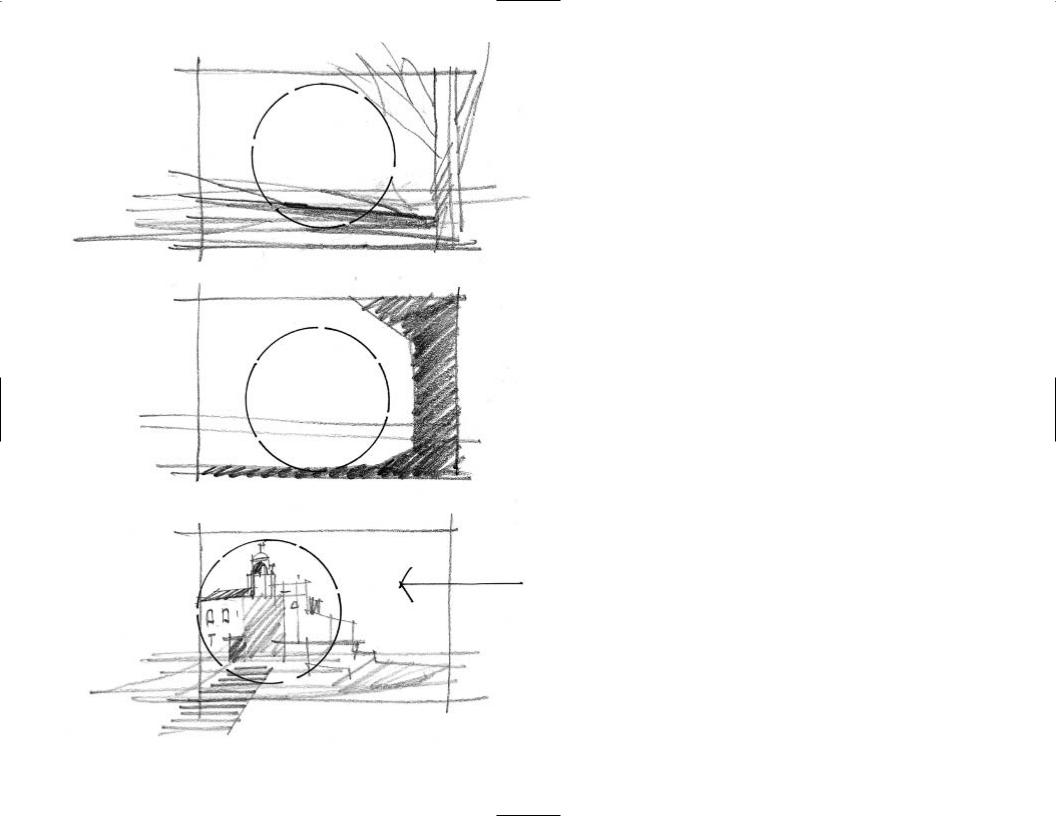
Shadows of trees on the ground
Contrast between dark planes and bright object
Framing by balance — strategic placement of the theme and using the “void” as a frame (reverse framing)
80
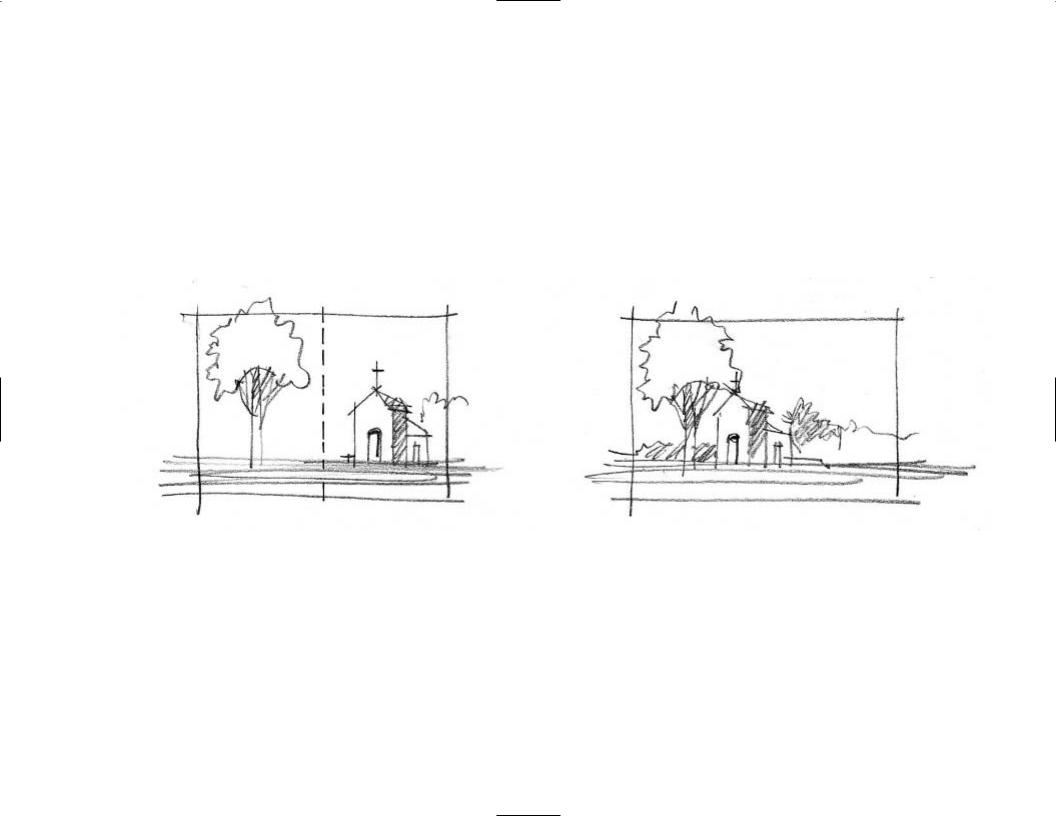
COMPOSITION
2. BALANCE
A seemingly balanced composition may be static and boring.
A composition taking advantage of the frame and shifting the thematic elements to one side; using the sky as counterbalance.
81
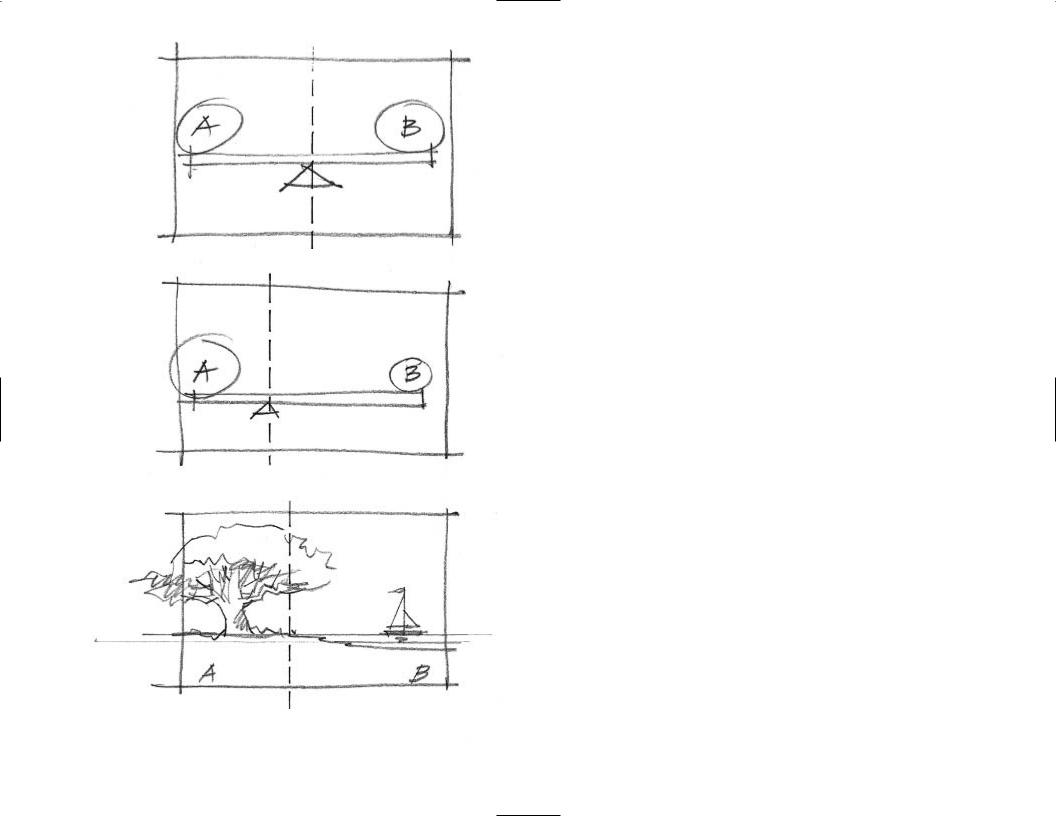
The key in learning balance is to avoid equal emphasis within the same picture frame.
This shows a static composition.
p
This shows a more dynamic composition by moving the pivoting point (“p”) off to one side.
p
This arrangement takes advantage of the space to the right of “p” and uses it to balance “A”— a very effective strategy when used with framing.
p
82
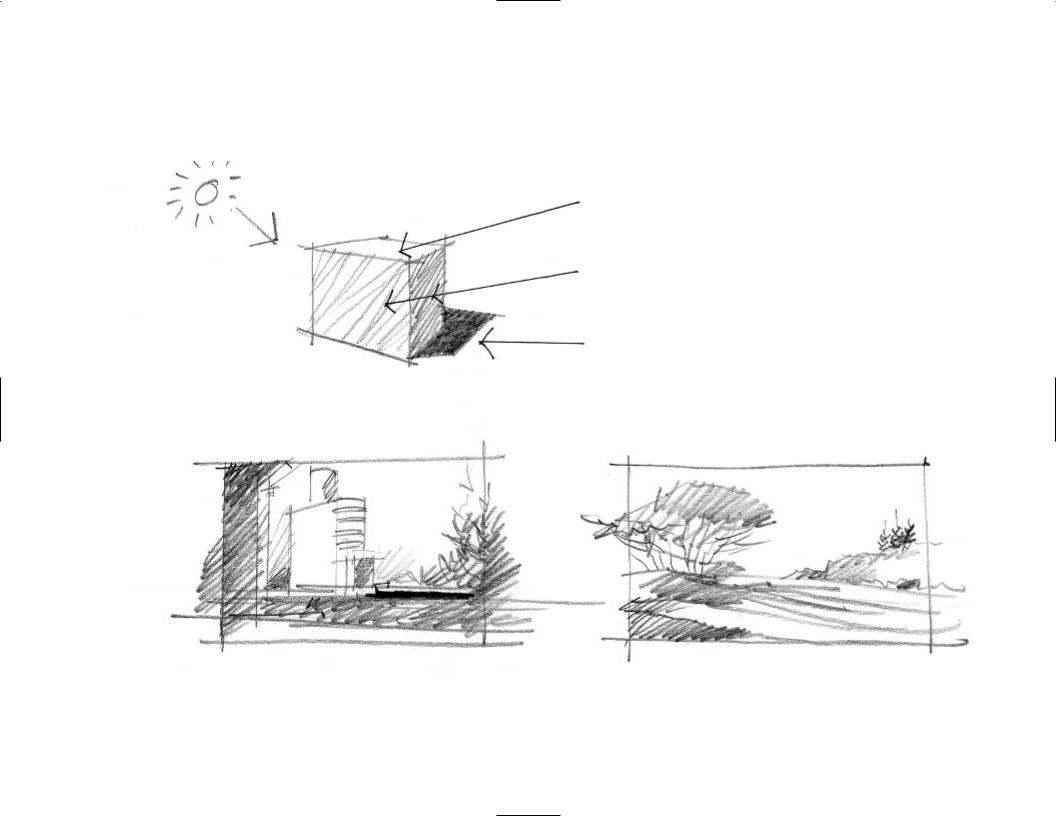
COMPOSITION
3. CONTRAST
Tonal contrast; difference in lighted and shaded planes; difference between light–shade–shadow.
plane in the sun
planes in the shade
shadow
83
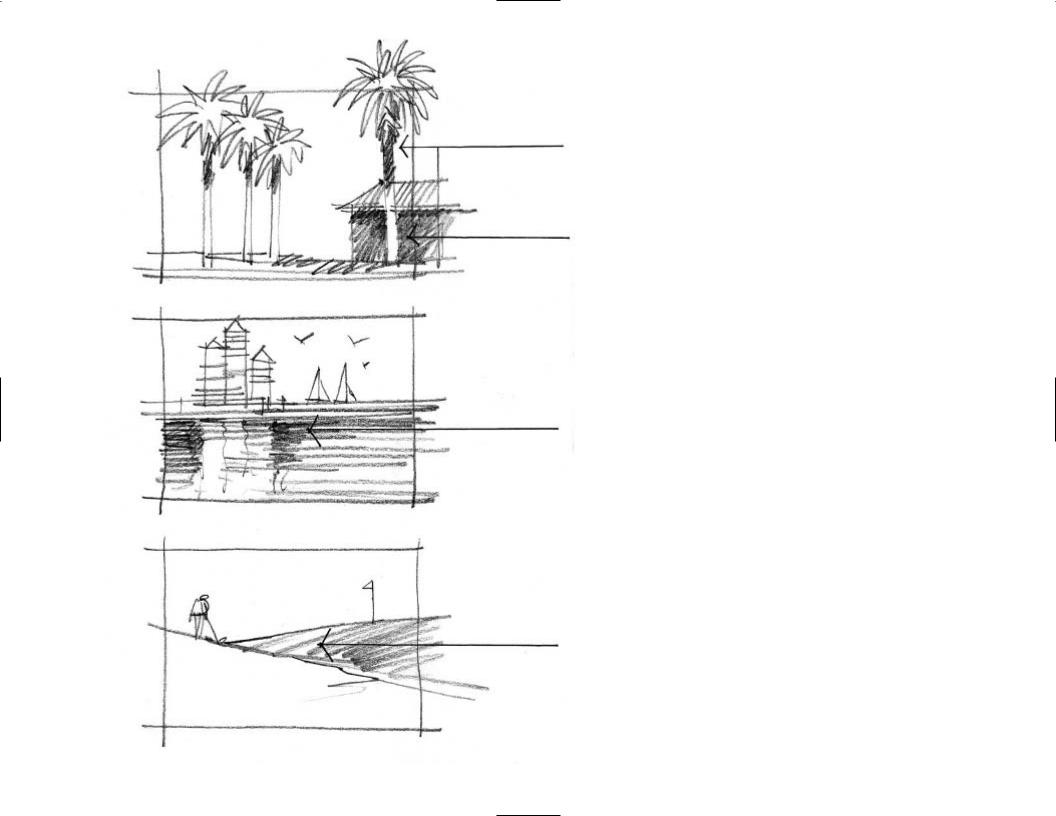
Tonal contrast at the base of the canopy is used to separate the trunk from the canopy.
Tonal contrast between building and tree trunk.
Reflection in water suggests the height of the buildings and the movement of the water’s surface.
Tonal contrast between foreground and background landform suggests the valley in between.
84
